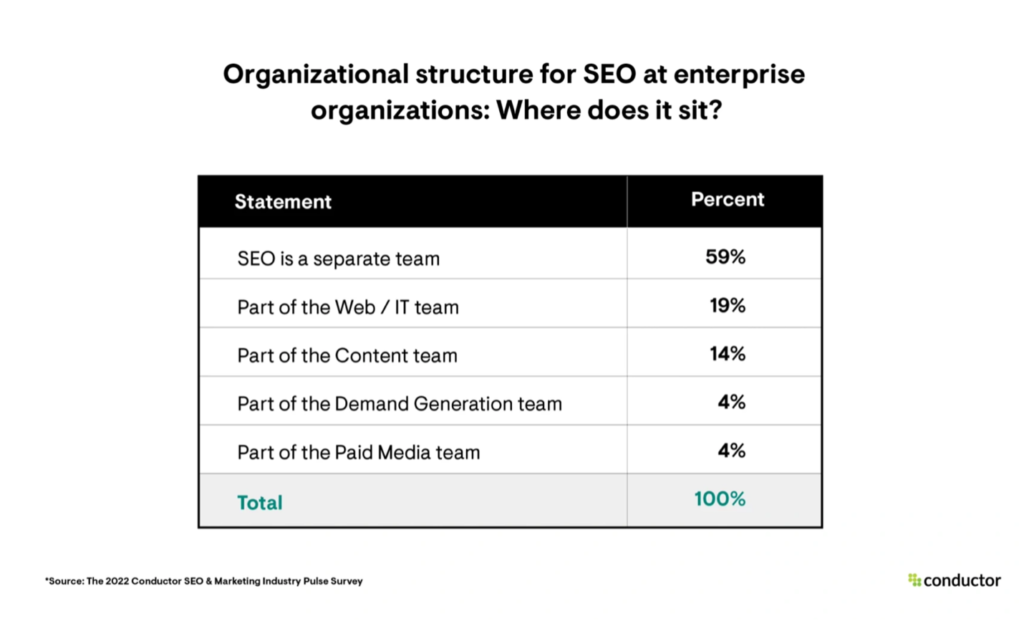As search engine optimization continues to evolve, its goals and functions merge with other disciplines, both in and out of marketing—from content to user experience to PR. So, where do SEO teams best fit in today’s org chart?
The placement of SEO teams can aid or hinder critical collaboration with different departments and shape the overall success of your SEO strategies. In this post, we explore SEO team structures in B2B enterprise organizations and unpack the pros and cons so you can find the one that is right for you.
Why Are SEO Teams So Hard to Place?
Finding the optimal SEO team placement within an organizational structure is a challenge for several reasons:
- Cross-functional nature: Contemporary SEO requires elements of marketing, UX, IT, content creation, and analytics. Determining where to place the SEO team depends on the skillset of your team and which of these elements take priority within your business.
- Variety of skillsets: Finding individuals with deep expertise across all SEO functions is its own challenge. People typically specialize in one of the four most common SEO types: technical SEO, SEO content, link building, or local SEO. Often, you must decide whether to place these specialists together or spread them across departments. Many teams will find that some SEO services and functions need to be outsourced.
- Organizational size: In smaller organizations, SEO teams or individuals might report directly to marketing, IT, or other departments. For larger businesses, it may work best to have a separate SEO department that comprises different specialties.
- Cultural factors: Organizational culture plays a role in determining where SEO teams fit. Some prioritize data-driven decision-making and technical SEO, while others may emphasize creativity and content creation.
- Lack of understanding: In some cases, organizational leaders may not fully understand the role of SEO teams or individuals, leading to placement decisions that don’t bring as much value.
- Evolution of SEO: SEO practices continue to evolve, making it difficult to pinpoint an obvious department for SEO to live in long term.
To overcome these challenges, organizations should recognize SEO’s multiple disciplines and foster a collaborative culture for SEO teams so they can work seamlessly with other departments.
Where Should SEO Sit in Your Org Chart?
There’s no one-size-fits-all approach to placing SEO teams within an organization. But Conductor’s 2022 Digital Marketing Salary Guide highlights common structures to consider.

To help you decide what works best for your company, let’s explore some pros and cons of SEO teams within these and other departments and how SEO collaborates with each.
SEO as a Standalone Team
A standalone team allows your business to create holistic SEO strategies that combine the strengths of both SEO content and technical specialists. A standalone team may also include local SEO and link building, or may oversee outside vendors focused on these specialties, ensuring that SEO strategies encompass the entire picture. These teams can be horizontal or act as a center of excellence that supports SEO initiatives across your entire business.
Option |
Pros |
Cons |
| Standalone SEO team |
|
|
SEO Team in Marketing or Demand Generation
Integrating SEO within your marketing team aligns organic search efforts with broader demand generation strategies. Within this team, SEO can contribute to the marketing pipeline, driving top-of-funnel traffic and supporting lead generation. However, in many businesses, lead gen may not be the only area where SEO can play an important role.
Option |
Pros |
Cons |
| SEO in the marketing/demand generation team |
|
|
SEO Team in Post-Sales
Placing SEO in your post-sales team shifts focus beyond top-of-funnel traffic to support later journey stages. Collaboration with other post-sales functions, such as customer service, allows for effective SEO strategies that address customer issues and reduce service interactions. Post-sales SEO also supports customer engagement by optimizing content like product documentation, learning materials, and user-generated content.
Option |
Pros |
Cons |
| SEO in the post-sales team |
|
|
SEO Team in Content
Content plays a significant role in SEO, and integrating SEO specialists into the content team ensures the creation of content that is optimized for search from the outset. The crossover between content creators and SEO specialists promotes effective collaboration that enhances creativity and search performance.
Option |
Pros |
Cons |
| SEO in the content team |
|
|
SEO Team in Public Relations
SEO and PR are a powerful collaboration for earning high-quality backlinks and brand awareness through digital media coverage. But this pairing may put a stronger focus on earned media and less on the growing importance of content quality, UX, and other factors within SEO strategy.
Option |
Pros |
Cons |
| SEO in the public relations team |
|
|
SEO Team in IT
Recent analysis from Search Engine Journal shows that implementing technical changes is the most common problem SEO teams face. Placing SEO teams or specialists within IT ensures that technical SEO implementation aligns with web product development. Prioritization and visibility of technical SEO projects in the IT pipeline prevents optimizations from languishing without implementation.
Option |
Pros |
Cons |
| SEO in the IT team |
|
|
Find What Works for Your Needs
There is no one right answer to where your SEO team should sit. Ultimately, a SEO team’s role and ideal placement depends on your overall organizational structure and broader business goals. A strong understanding of your SEO needs and existing team functions is the first step toward ideal placement. Set your team within a structure where they can best use their skills to support the main business objectives.
SEO specialists and teams will struggle to see results when stuck in a silo. When your SEO team is empowered to collaborate cross-functionally or operate as a center of excellence, they will be able to create a positive impact across multiple departments in your organization.
Need Help With SEO?
Talk to Tendo about SEO strategies that support your organization’s goals. Contact us.










